Featured Application
Self-standing insulating panels with thermal conductivity as low as 0.115 W/mK and compressive strength around 2–3 MPa can be produced with 9 wt% of cork waste.
Abstract
Cork powdery waste (CW) from agglomerated cork caps manufacturing is commonly transported to waste-to-energy plants, although it could be locally exploited for lightweight building materials. The transformation of CW into a geopolymer formulation to obtain a novel composite formulation suitable for insulating panels is presented in this contribution. The geopolymer mix was based on metakaolin added to NaOH and Na silicate solutions, to which 2.4, 4.8 and 9.1 wt% (calculated upon dry metakaolin) of CW in the form of as-received powdery waste were added. No pre-treatments were performed on CW and no thermal curing was conducted for the alkali-activated product that was consolidated at room temperature to improve product sustainability. The insulating panel presented an apparent density of about 1.521 to 0.990 ± 0.001 g/cm3, combined with a total porosity in the range of 35.61 to 56.22 ± 0.003 % for 2.4 to 9.1 wt% of CW, respectively, and this was dependent upon ageing time. The values of its mechanical properties (compressive strength ranged from 2.5 to 1.5 MPa at 28 and 90 days of curing time, complying with UNI EN 998-2) and thermal insulating properties (thermal conductivity around 0.1146 W/mK) indicated that the highest percentage of CW in the formulations, i.e., 9.1 wt%, was suitable to obtain self-standing insulating panels.
1. Introduction
Geopolymers have been extensively studied as building materials. These types of materials were developed from an aluminosilicate precursor and an alkaline agent as a greener substitute for ordinary Portland cement (OPC) [1]. After hardening, a semi-crystalline amorphous material similar to concrete is produced [2]. The geopolymerization reaction can take place at room temperature or even at higher temperatures, depending on the final product to be obtained [1]. The strength of geopolymers varies according to the conditions under which the geopolymerization takes place [3]. Geopolymers can be produced from a variety of aluminosilicate natural or industrial precursors in the form of powders or slurries [1].
The most common sources of aluminosilicates used for geopolymer production are kaolin, metakaolin and by-products such as fly ash [4], granulated blast furnace slags [5], ladle slags [6]. The use of these last three types of partially amorphous aluminosilicate precursors to produce geopolymer cements significantly reduces the amount of CO2 of construction projects by 80%, compared to OPC [1].
The powdery precursors for geopolymeric materials should be rich in alumina (Al2O3) and silica (SiO2) contents, preferably in the reactive amorphous form [1,2,3,4], for fast dissolution when in contact with the alkaline agent. These alkaline activators must be carefully selected in terms of type (NaOH, rather than KOH and/or sodium silicate) and concentration (typically from 6 to 10 M) in order to produce the proper degree of dissolution of the precursor to assure the correct development of compressive strength in hardened geopolymers [1]. To obtain a better dissolution of the aluminosilicates present in the various classes of raw material, many authors work at pH values higher than 13 [1,2].
The result of geopolymerization [1,2] is a semi-crystalline amorphous substance composed of solid phases of aluminosilicates assembled on the basis of SiO44− and AlO45− bonds as a tetrahedra that forms a 3D structure.
Geopolymers have many characteristics in addition to eco-sustainability. As an example, geopolymers are excellent fireproof materials and are resistant to corrosive environments. In addition, geopolymers have excellent compressive strength and thermal properties. Geopolymers are also impermeable to water [1].
A degree of resistance to fracture propagation can be obtained with the addition of natural fibers [7,8] and synthetic fibers [9], etc., although compromising the fire resistance. To improve fire resistance while maintaining the lightweight nature of the material for non-structural composites, waste cork was added to the matrix. In previous works [10,11,12,13,14], the use of cork has been discussed, but few articles have focused on the use of cork waste in mortars and concrete [15].
In this study, powdery waste from agglomerated cork bottle caps (CW) was introduced into metakaolin (MK) geopolymer fresh paste in increasing amounts from 2.4 to 9 wt%. Cork waste was taken from the manufacturing process of agglomerated cork bottle caps and, as they contain residues of binders and additives for cork particles, namely polyurethane glue and paraffin, they seem to be suitable for a cold process such as geopolymerization. The introduction of cork residue as a filler in a geopolymer matrix could reduce water consumption during the production phase and prolong setting times, thus leading to a more extended geopolymerization process, as reported by Sudagar et al. [15]. Furthermore, the beneficial properties of cork could be exploited, including their lightness, impermeability to liquids and gasses, neutrality and chemical resistance, resistance to biological corrosion, thermal insulation properties, acoustic and anti-vibration properties, incombustibility, elasticity, durability, neutrality for health and mechanical resistance. Four formulations of composites were prepared to observe how the increasing amounts of CW could affect the physico-mechanical properties of the hardened product. Through the loss of weight and water, the cross-linking of the 3D network was confirmed. Then, optical microscopy, apparent density and compressive strength tests were carried out to detect the influence of cork waste addition on the microstructure and mechanical properties of the geopolymer matrix. Finally, the thermal conductivity was measured with the hot plates method.
2. Materials and Methods
2.1. Materials
The metakaolin (MK) used in this study was ARGICAL™ M1000 (Imerys, Paris, France, with the following chemical composition reported by the producer: SiO2 = 55%; Al2O3 = 40%, Fe2O3 = 1.4%; TiO2 = 1.5%; Na2O + K2O = 0.8%; CaO + MgO = 0.3%; LOI = 1%). Its particle size distribution is represented in Figure 1, with respect to that of the industrial cork residue used within the sample’s formulations. The waste material used in this study was waste cork from the manufacturing process of agglomerated cork bottle caps of a local company (Italsughero, Montecchio Emilia (RE), Italy). The waste residue is collected through a cyclonic air filtering system. The collected residue is in powder form and is formed during the smoothing phase of the cork stoppers. These cork scraps have a particle size distribution of 0.063 mm < diameter < 1 mm (Figure 1) and contain polyurethane glue and traces of paraffin used industrially as binders and additives for the cork particles, respectively. A more detailed cork waste characterization is described by B. Malchiodi et al. in a previous work [16].
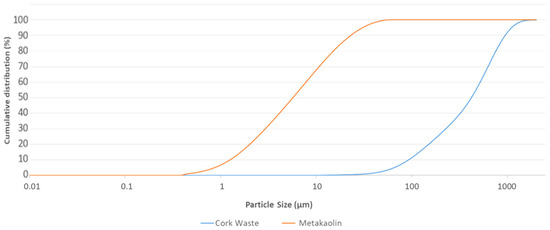
Figure 1.
Comparison of particle size cumulative distribution curves of pure metakaolin (MK) and cork waste (CW).
The NaOH solution was prepared by dissolving laboratory grade granules (96 wt%, Sigma - Aldrich Italia s.r.l., Milan, Italy) into distilled water to obtain a 8 M concentration. The sodium silicate solution (SiO2/Na2O = 3.00 molar ratio; SiO2 = 26.50 wt%, Na2O = 8.70 wt% and pH = 11.7) with a density of 1.373 g/dm3 at 20 °C was used in the formulation of the geopolymers in combination with NaOH. The solution of sodium silicate was provided by Ingessil s.r.l., Verona, Italy.
2.2. Preparation of Geopolymer Specimens
To a certain amount of MK dry powder, the addition of 8 M NaOH plus sodium silicate solution was carried out under mechanical stirring to obtain the reference geopolymer formulation, hereafter indicated as GP0. To this formulation, different percentages of cork waste powder (namely those equal to 2.44, 4.76 and 9.09 wt% calculated upon a dry MK basis) were added to produce the geopolymer composites labelled GP-2.4CW, GP-4.8CW and GP-9.1CW, respectively (Table 1). This range of CW additions was chosen after some preliminary tests during which we found out that the addition of an amount around 10 wt% was creating workability problems and required too much water.

Table 1.
Geopolymer formulations (L/S = liquid to solid ratio, see text for description).
Details of the geopolymer mixes are reported in Table 1. It should be noted that in the cases of two formulations, the addition of water was necessary to maintain the workability of the fresh pastes. As a result of the water addition, the liquid (L) (NaOH and sodium silicate solutions plus water) to solid (S) ratio (MK and cork powder) was kept around 0.65–0.68 (see Table 1).
All the fresh pastes were prepared by mixing powders and liquids in a planetary mixer (Aucma 1400W, Acuma CO., LTD., Shandong, China). The fresh paste was poured into silicone cubic molds (25 × 25 × 25 mm3) and into plastic molds (245.54 × 233.82 × 26.37 mm3) for thermal conductivity testing. After removing all the bubbles with the vibrating table, the molds were carefully sealed and the geopolymers were cured at room temperature at 100% relative humidity. The silicone molds were opened after 1 day of curing time. A minimum of 6 samples per each formulation was obtained. The characterization of all the samples was carried out after 28 and 90 ageing days.
2.3. Weight Loss upon Curing and Chemical Stability in Water
In order to monitor how much the presence of cork could affect the drying step of the geopolymeric pastes, the progressive weight loss of the cork composites was monitored for the first week every day and then every 7 days for a total of 28 days.
Additionally, to test the consolidation of the geopolymeric paste in the presence of cork, the chemical stability in water was checked after 1 day of curing with the integrity test [17]. Distilled water (1:100 solid–water weight ratio) was added to the sample, with amounts ranging from 1.51 to 2.34 g. After 24 h, the sample was removed from the water and the integrity was evaluated by estimating the following: (i) the samples’ smoothness; (ii) the samples’ resistance to finger pressure; (iii) the eluates’ color and transparency.
2.4. Apparent Density, Real Density and Porosity
Apparent density, ρa, was geometrically evaluated as the ratio between the measured mass and the known volume of the cubic samples [18]. The mean apparent density of each hardened composite was computed as the average over three measurements. Real density, ρr, was measured through a helium pycnometer (Micrometrics Accupyc 1330, Micrometrics Instruments, Norcross, GA 30093, USA) using a weighted amount of a pulverized sample.
Using the real and apparent density values, the following formula was used to obtain the total porosity P% value:
P% = (1 − ρa/ρr) × 100
2.5. Optical Microscopy
Optical microscopy (Leica EZ4D, Leica Microsystems, Germany) with 8×, 20× and 35× magnifications was used for the morphological description of cork waste composites. The light used was in the visible spectrum. The resolving power of the optical microscope was 0.2 µm. The test was carried out on samples aged over 28 days. Image elaboration used to measure the surface area was carried out with IMAGEJ, 1.52v, (Open Source, copyright by the author W. Rasband, National Institute of Mental Health, Bethesda, MD, USA). The areas covered by the dark cork particles were calculated via IMAGEJ software.
2.6. Mechanical Properties
To test the mechanical properties of the MK-based geopolymers with 0, 2.4, 4.8 and 9.1% wt of cork waste, compression tests were performed with an Instron 5567 Universal Testing Machine (Norwood, MA, USA) after 28 and 90 days of curing. For the tests, cubic samples were used. The load (30 kN load limit) was applied and increased by a displacement rate of 1 mm/min. The tests were executed in the displacement control mode at a constant loading velocity and with no preload. All the tested samples were compared to EN 998-2 [19]. They were stopped after obtaining three valid tests for each different geopolymer composition. Compressive strength values were assumed to be the arithmetic mean value of four tests with the mean absolute deviation.
2.7. Thermal Conductivity
The thermal conductivity of GP0 and GP-9.1CW was measured through a heat flow meter (HFM Lambda, Netzsch-Gerätebau GmbH, Selb, Germany) after 28 days of curing. Furthermore, if the geopolymer with 9.1 CW is not insulating enough, then this will also be the case with lower additions. The equipment was calibrated with certified reference materials (NIST SRM 1450d) and it was designed according to the standards ASTM C518 [20]. The mean thermal conductivity was calculated as the average over three measurements. Figure 2 shows the flat surfaces of the front and rear sides of the plate used for the test, with dimensions of 245.54 mm in length × 233.82 mm in width × 26.37 mm in thickness. The plates were dried at room temperature and in contact with the laboratory atmosphere to ensure a constant weight before the thermal conductivity measurements.
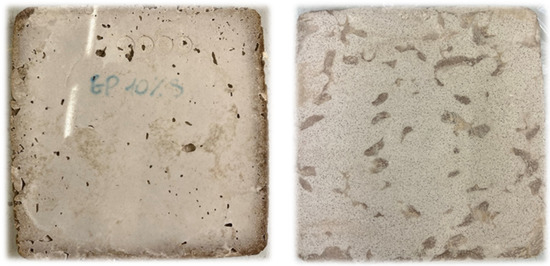
Figure 2.
Images of the front and rear sides of the GP-9.1CW sample used for thermal conductivity test.
3. Results
3.1. Weight Loss upon Curing and Chemical Stability in Water
Figure 3 shows the weight loss of the geopolymeric samples during the first 28 days of ageing. It can be observed that the presence of cork waste greatly affects weight loss, namely, the value of weight loss recorded for the GP0 reference geopolymer is 3.016%, and it increases at around 10% for formulations GP-2.4CW (10.364%) and GP-4.8CW (10.941%). This behavior is related to the capacity of cork to absorb water and then slowly release it. The high weight loss observed for the GP-9.1CW sample (20.872%) was probably due to the excessive use of water to work the sample, as already mentioned in Section 2.2.
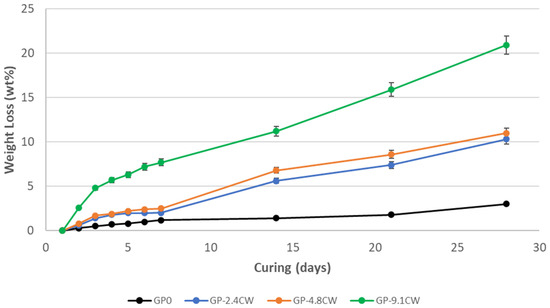
Figure 3.
Weight loss of all geopolymers during the first 28 days of ageing.
Furthermore, the final step of geopolymerization is the condensation of two proximate groups of Si-OH or one Si-OH and one Al-OH with the elimination of a water molecule that can be eliminated during the natural drying of the paste via surface evaporation. As all the specimens were prepared with identical shapes and sizes, the surface area was exactly the same for all the specimens. The different rate of water loss via evaporation is then due to the specific microstructure of each single composite, with the GP-9.1CW sample demonstrating the highest porosity (see also measurements of total porosity in Section 3.2). It is well-known in the literature that the water retention properties of samples depend on their pore size, with larger sizes giving both higher water absorption and water release rates [21]. It is evident how the presence of cork in the composites under investigation facilitates water loss, as reported by the water retention values measured after 28 days and presented in Table 2 for all the formulations. Furthermore, the minimum value of water retention recorded for the GP-9.1CW sample could be attributed to a specific peculiarity of the inner bark of the cork oak (Quercus suber L.), which consists of a structure of air-filled cells, resulting in a waterproof, light and flexible structure [22].

Table 2.
Percentages of total water, water loss and retention in the different formulations after 28 days of ageing.
The addition of water during composite preparation was necessary to reach the proper workability of the paste. The consequence of such an addition of water was the dilution of the alkaline solution used as the activator of the entire process of geopolymerization, which could have prevented proper reticulation. For this reason, the confirmation of the degree of the reticulation of the geopolymeric aluminosilicate matrix was indirectly measured by the integrity test in water of the consolidated composites [23]. After the required 24 h of immersion in water, the samples were extracted and examined. All samples were found to be intact and resistant to finger pressure, indicating that the geopolymerization took place correctly. The eluates presented a yellowish color that became more intense as the percentage of cork increased, indicating the presence of natural tannins.
3.2. Density and Porosity
Depending on the ageing time of the samples, a difference in the density and porosity of a typical MK-based geopolymer can be noted (Table 3) [1]. Additionally, the cork is a material that is very sensitive to humidity and is porous. It is estimated that about 800 million cells are present in a single wine cork stopper due to the fact that the inner bark of the cork oak tree is composed of layers of living, growing tissues, formed of independent tetradecahedron cells (20 to 40 million per cubic centimetre structure) [22]. This cellular structure remains even after the cork has been processed to obtain stoppers.

Table 3.
Real density and porosity of geopolymers with CW after 7 and 28 days.
In Figure 4, it can be observed how the apparent density decreases as the percentage of cork increases after 28 days, as a light and porous material is inserted into the geopolymer matrix that lightens the compound. Regarding the real density, it remains almost constant with a slight decrease for the 9.1 sample.
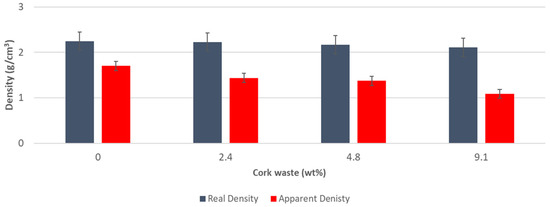
Figure 4.
Real density and apparent density of all geopolymers after 28 days.
Within the same formulation, the apparent density decreases with curing time (Figure 5). This is probably due to the fact that cork retains water, which, over time, manages to evaporate, making the material lighter, and therefore less dense and also more porous, as shown by the porosity trend of Figure 6.
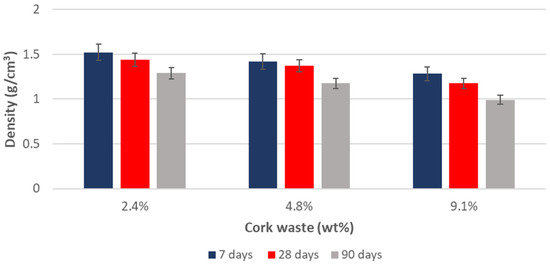
Figure 5.
Apparent density of all geopolymers after 7, 28 and 90 days.
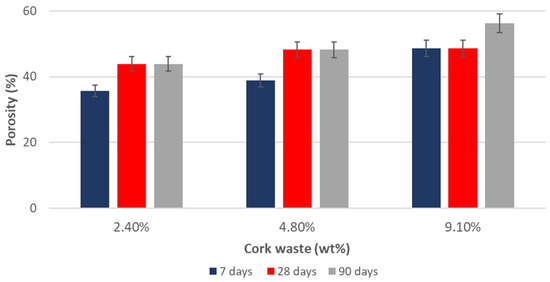
Figure 6.
Porosity of all geopolymers after 7, 28 and 90 days.
The trend of total porosity reflects what was observed in the first 28 days in Figure 3, which reports the water loss values during drying. The values reported in Figure 6 demonstrate the trend over the first 90 days of ageing, indicating the very high porosity value (approx. 56%) of the sample with the highest cork waste content. At this point, it should be remembered that geopolymers based on metakaolin present an intrinsic nanoporosity of about 35–40%, with nanopores in the mesoporous range (2–50 nm) [24]. The evaporation of condensation water through these very fine pores is difficult, but it enhances the presence of cork powder and some voids around it, due to the difficult workability of the material as a fresh geopolymer paste.
3.3. Optical Microscopy
The optical microscopy images (Figure 7) showed the very homogeneous microstructure of the composites without any separation of cork waste in the upper part of the specimens. This observation confirmed that the viscosity of the paste was high enough to prevent the lighter cork particle from floating on top of the denser geopolymeric matrix. The geopolymeric paste and CW powder mixing efficiently distributed the cork particles within the entire composite volume without any aggregation.
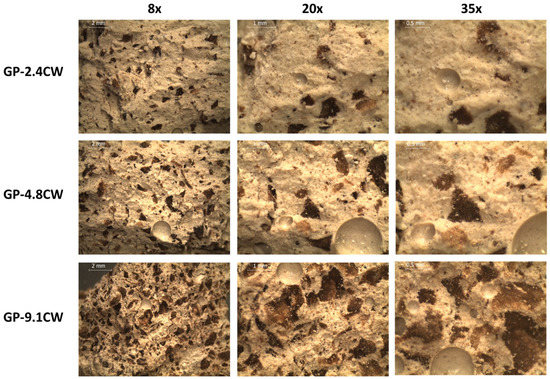
Figure 7.
Optical microscopy images of the CW formulations with different magnifications (2, 1 and 0.5 mm bar are reported in each photograph, depending on the enlargement).
From the optical micrographs (Figure 7), it is possible to observe the presence of pores with variable diameters, from 0.5 to 1.7 mm, which are clearly identified as air bubbles trapped in the geopolymeric paste. The presence of pores in GP-2.4CW and GP-4.8CW is quite similar, although we can note the presence of some larger pores in the geopolymer with 4.8% cork. In GP-9.1CW, on the other hand, there is a greater quantity of pores, reflecting the data obtained with the real and apparent densities. Therefore, the presence of cork leads to a higher porosity in the geopolymers, not only due to the presence of cork itself, but because this material makes the geopolymer in the fresh state much less workable and pastier, a feature that makes correct vibration, and therefore the correct elimination of the air inside the paste, more difficult (see image of GP-9.1CW sample at 35× magnification).
The adhesion of the cork particle to the geopolymeric matrix is very good and traces of cork decolorized areas that indicate degradation are absent.
The areas covered by the dark cork particles (Figure 7) have been calculated via IMAGEJ software to be approximately equal to 5.85 ± 0.55%; 12.35 ± 2.65%; and 24 ± 1.49% for samples with 2.4, 4.8 and 9.1% cork waste. This value is the threshold limit of the amount of CW that we could insert in the geopolymeric paste without losing the degree of workability necessary to fill in the mold.
3.4. Compressive Strength
The addition of cork to cementitious mortar leads to a decrease in the mechanical properties of the final product. However, it has been demonstrated that it does not affect it excessively and the final products remain classifiable, according to the resistance classes of UNI EN 998-2, i.e., 4.50 MPa, with up to 9.1% cork waste [25].
In the present investigation, the compressive strength tests were carried out after 28 and 90 days of curing on all the geopolymer samples. From Figure 8, it is possible to notice that after an addition of 2.4, 4.8 and 9.1% of cork waste, the values change. In geopolymers with 2.4% and 4.8% of waste cork, an increase in the value of the mechanical compressive strength can be observed, with the time duration confirming that geopolymerization occurs and it is not hindered by cork powder. In the case of GP-9.1CW specimens, the compressive strength values are so low that it is difficult to assess a trend.
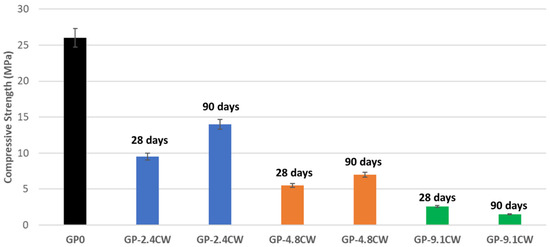
Figure 8.
Compressive strength for all the samples after 28 and 90 days.
In order to increase the resistance to compression, a fraction of fine aggregates (quartz sand, nepheline syenite or ladle slag) can be added to the formulation with the beneficial effect of removing the residual hydroxides species as reported in the literature [26].
3.5. Thermal Conductivity
The thermal conductivity test was performed on the formulation without CW and on the GP-9.1CW with 9.1% of cork waste aged for 28 days. The thermal conductivity, K, value found was 0.1146 ± 0.0001 W/mK. Such a value is comparable to that of 0.122 ± 0.03 W/mK, which was recorded for a MK geopolymeric sample with 87 ± 2.5 vol% of porosity obtained by adding Al powder [27]. Considering the total porosity of GP-9.1CW around 56% with a 24 vol% content of cork, the present formulation contains around 80 vol% of the insulating phase (pores and cork), very closely resembling the material reported in the literature. In their work [28], Kamseu et al. also reported values of thermal conductivity around 0.5–0.6 W/mK for several geopolymer formulations with different Si/Al ratios in their dense state, which is very close to the value obtained for GP0 of about 0.45 W/mK.
In Figure 9, GP-9.1CW has been compared with other geopolymers from the literature [29,30,31]. It can be noted that compared to different formulations of geopolymers with only metakaolin, the value is much lower. In addition, if compared with classic building materials such as concrete (K ≈ 0.28 W/mK for insulating mortars; K ≈ 1.6 W / mK for base mortars [29]), this value is much lower and is almost 1/3 lower for insulating mortars and even almost 15-times lower than the thermal conductivity of base mortars. Despite this, it is not possible to define the resulting geopolymer as a proper thermal insulator, since it would be necessary to reach K values of at least 0.06–0.09 W/mK according to UNI EN 998-1 [16,32]. However, the K value obtained for the GP-9.1CW composite is a good result in view of considering the geopolymer as a surface that is not very sensitive to heat, not perfectly insulating, but demonstrates better performance when compared to classic building materials.
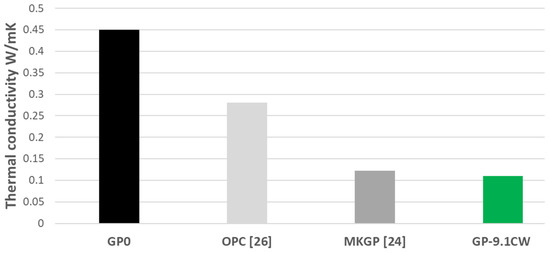
Figure 9.
Thermal conductivity values for samples GP0 and GP-9.1CW after 28 days compared to the literature data of aerated Portland cement (OPC) and porous MK-based geopolymers (see text for explanation).
4. Discussion
The addition of lightweight waste materials in geopolymers is not studied enough [7,14], even though this type of waste could beneficially affect both the cost of disposal and the future application of geopolymers as insulating materials. Additionally, in the literature, there are only a few cases of the valorization of waste cork used as a lightweight filler or aggregate [10].
In the preliminary step of our research on the use of as-received waste cork, we focused our efforts on obtaining a workable formulation of geopolymers, as reported in the present manuscript. After verifying the successful cross-linking of the geopolymeric network, we moved on to the physical, mechanical, chemical and microstructural characterization of the geopolymers.
In comparison to other studies on geopolymer composites with lightweight materials, especially those that waste cork, and after the analysis of the results reported in the previous sections, the following remarks can be drawn:
- ▪ When compared to cement composite, the very same waste cork produced stronger materials with the use of MK-based geopolymers. The compressive strength following the addition of about 2.5% of cork in this study is around 10 MPa; on the contrary, in [16], the values do not exceed 2 MPa. A similar trend occurs with the addition of about 5% of CW.
- ▪ In the MK-based geopolymer matrix, the lightweight compositions reported in the study [10] do not exceed 5 MPa. Specifically, these authors reported a pyrolyzed cork addition of about 2.5–3.75 wt% with 3.5–5.0 MPa.
- ▪ Thermal insulation materials play an important role in construction. The production of new insulating materials makes it possible to reduce the energy consumption of buildings. External walls are one of the most important structural elements of buildings. In Ashby’s chart (Figure 10), which demonstrates common applications of lightweight building materials/ceramics provided in the ANSYS GRANTA EduPack R2021, it can be observed that our geopolymer lightweight composites are within the range of insulating and building materials commonly used [33]. Concerning the values of thermal conductivity reported in the literature in the study [14], we can confirm that our value of about 0.11 W/mK is lower than those recorded for 18 vol% pyrolyzed cork, i.e., 0.56 W/mK.
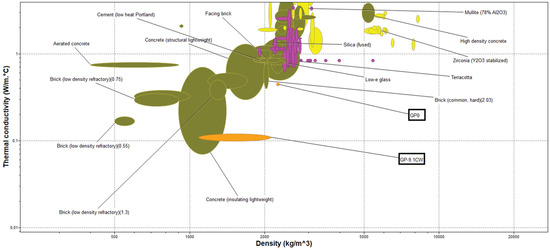 Figure 10. Ashby chart: thermal conductivity vs density for GP0 and GP0-9.1CW in comparison to other insulating inorganic materials.
Figure 10. Ashby chart: thermal conductivity vs density for GP0 and GP0-9.1CW in comparison to other insulating inorganic materials.
The absence of cork waste pre-treatments and thermal curing of the final composites allowed us to indicate the mixes optimized in this work as sustainable fire-resistant insulation materials with a reduced environmental footprint, when compared to expanded polystyrene systems [34].
5. Conclusions
The room temperature consolidation of metakaolin-based geopolymeric composites has been successfully achieved with increasing contents of as-received cork waste, ranging from 2.4 to 9.1 weight%. The viscosity of the geopolymeric paste was suitable to englobe the powdered cork without floating or cracking during the first hours of the setting and drying processes of the composites.
The presence of the cork powder did not alter the reticulation process of the geopolymer that resulted in a chemically stable composite, with the cork acting as an inert and lightweight filler. With increasing cork content, the composites rapidly decreased the water retention rate and increased the porosity, indicating the possible application of these materials for indoor humidity control.
The compressive strength test, when compared to the reference GP0 material, provided good results, essentially depending on the amount of waste cork. The formulation GP-9.1CW with 9.1% of added waste cork recorded an extremely low thermal conductivity value of 0.1146 ± 0.0001 W/mK, which was even lower than the corresponding porous geopolymer solid with similar porosity.
Author Contributions
Conceptualization, G.D.P. and C.L.; methodology, C.L.; investigation, G.D.P. and R.M.; resources, L.B.; data curation, R.M. and I.L.; writing—review and editing, G.D.P. and C.L.; supervision, C.L. and L.B. All authors have read and agreed to the published version of the manuscript.
Funding
This research received no external funding.
Institutional Review Board Statement
Not applicable.
Informed Consent Statement
Not applicable.
Data Availability Statement
Not applicable.
Acknowledgments
The authors are grateful to Sophie Maraninchi, Product Manager Refractory, Abrasives and Constructions Business Area, Imerys, France, and Paola Morsiani, Sales Manager, Performance Minerals EMEA/Ceramics, Imerys Ceramics Italy for the metakaolin supply. The authors express their gratitude to Mirko Braga, Ingessil, Montorio, Italy, for supplying the sodium silicate solution and Italsughero of F.lli Correggi S.r.l. (Montecchio Emilia—RE, Italy) for the supply of the cork waste.
Conflicts of Interest
The authors declare no conflict of interest.
References
- Provis, J.L.; Van Deventer, J.S.J. Geopolymers: Structure, Processing, Properties and Industrial Applications; Woodhead Publishing: Cambridge, UK, 2009. [Google Scholar]
- Castillo, H.; Collado, H.; Vesely, M.; Garrido, P.; Palma, S. State of the art of geopolymers: Review. Polymers 2022, 22, 108–124. [Google Scholar] [CrossRef]
- Torgal, F.; Labrincha, J.A.; Leonelli, C.; Palomo, A.; Chindaprasirt, P. Handbook of Alkali-Activated Cements, Mortars and Concretes, 1st ed.; Series in Civil and Structural Engineering; Woodhead Publishing: Cambridge, UK, 2014. [Google Scholar]
- Van Deventer, J.S.J.; Provis, J.; Duxson, P. Technical and commercial progress in the adoption of geopolymer cement. Miner. Eng. 2012, 29, 89–104. [Google Scholar] [CrossRef]
- Dos Anjos, M.A.G.; Sales, A.T.C.; Andrade, N. Blasted copper slag as fine aggregate in Portland cement concrete. J. Environ. Manag. 2017, 196, 607–613. [Google Scholar] [CrossRef] [PubMed]
- Bignozzi, M.C.; Manzi, S.; Lancellotti, I.; Kamseu, E.; Barbieri, L.; Leonelli, C. Mix-design and characterization of alkali activated materials based on metakaolin and ladle slag. Appl. Clay Sci. 2013, 73, 78–85. [Google Scholar] [CrossRef]
- Zaid, O.; Martínez-García, R.; Abadel, A.A.; Fraile-Fernández, F.J.; Alshaikh, I.M.H.; Palencia-Coto, C. To determine the performance of metakaolin-based fiber-reinforced geopolymer concrete with recycled aggregates. Arch. Civ. Mech. Eng. 2022, 22, 114. [Google Scholar] [CrossRef]
- Kamga Samen, V.E.L.; Nemaleu, J.G.D.; Kaze, R.C.; Kammogne, F.D.; Meukam, P.; Kamseu, E.; Leonelli, C. A Low Thermal Conductivity of Lightweight Laterite-cement Composites with Cotton Wastes Fibres. Silicon 2022, 14, 8205–8222. [Google Scholar] [CrossRef]
- de Azevedo, A.R.G.; Cruz, A.S.A.; Marvila, M.T.; de Oliveira, L.B.; Monteiro, S.N.; Vieira, C.M.F.; Fediuk, R.; Timokhin, R.; Vatin, N.; Daironas, M. Natural Fibers as an Alternative to Synthetic Fibers in Reinforcement of Geopolymer Matrices: A Comparative Review. Polymers 2021, 13, 2493. [Google Scholar] [CrossRef]
- Novais, R.M.; Saeli, M.; Caetano, A.P.F.; Seabra, M.P.; Labrincha, J.A.; Surendran, K.P.; Pullar, R.C. Pyrolysed cork-geopolymer composites: A novel and sustainable EMI shielding building material. Constr. Build. Mater. 2019, 229, 116930. [Google Scholar] [CrossRef]
- Dawcznski, S.; Gorski, M.; Krzywon, R. Granulated cork as a component of geopolymer—Preliminary studies. Ann. Wars. Univ. Life Sci.-SGGW For. Wood Technol. 2016, 94, 124–128. [Google Scholar]
- Novais, R.M.; Carvalheiras, J.; Senff, L.; Lacasta, A.M.; Cantalapiedra, I.R.; Giro-Paloma, J.; Seabra, M.P.; Labrincha, J.A. Multifunctional cork—Alkali-activated fly ash composites: A sustainable material to enhance buildings’ energy and acoustic performance. Energy Build. 2020, 210, 109739. [Google Scholar] [CrossRef]
- Novais, R.M.; Senff, L.; Carvalheiras, J.; Seabra, M.P.; Pullar, R.C.; Labrincha, J.A. Sustainable and efficient cork—Inorganic polymer composites: An innovative and eco-friendly approach to produce ultra-lightweight and low thermal conductivity materials. Cem. Concr. Compos. 2019, 97, 107–117. [Google Scholar] [CrossRef]
- Samuel, D.M.; Inumerable, N.; Stumpf, A.; Kriven, W.M. Thermal conductivity of several geopolymer composites and discussion of their formulation. Int. J. Appl. Ceram. Technol. 2022, 20, 475–486. [Google Scholar] [CrossRef]
- Sudagar, A.; Andrejkovicova, S.; Patinha, C.; Velosa, A.; McAdam, A.; Ferreira da Silva, E.; Rocha, F. A novel study on the influence of cork waste residue on metakaolin-zeolite based geopolymers. Appl. Clay Sci. 2018, 152, 196–210. [Google Scholar] [CrossRef]
- Malchiodi, B.; Marchetti, R.; Barbieri, L.; Pozzi, P. Recovery of cork manufacturing waste within mortar and polyurethane: Feasibility of use and physical, mechanical, thermal insulating properties of the final green composite construction materials. Appl. Sci. 2022, 12, 3844. [Google Scholar] [CrossRef]
- Lancellotti, I.; Catauro, M.; Ponzoni, C.; Bollino, F.; Leonelli, C. Inorganic polymers from alkali activation of metakaolin: Effect of setting and curing on structure. J. Solid-State Chem. 2013, 200, 341–348. [Google Scholar] [CrossRef]
- Lee, J.R.; Hasolli, N.; Jeon, S.M.; Lee, K.S.; Kim, K.D.; Kim, Y.H.; Lee, K.Y.; Park, Y.O. Optimization fluidization characteristics conditions of nickel oxide for hydrogen reduction by fluidized bed reactor. Korean J. Chem. Eng. 2018, 35, 2321. [Google Scholar] [CrossRef]
- Thamboo, J.; Jayarathne, N.; Bandara, A. Characterisation and mix specification of commonly used masonry mortars. SN Appl. Sci. 2019, 292. [Google Scholar] [CrossRef]
- ASTM C518; Standard Test Method for Steady-State Thermal Transmission Properties by Means of the Heat Flow Meter Apparatus. ASTM: West Conshohocken, PA, USA, 2021.
- Okada, K.; Ooyama, A.; Isobe, T.; Kameshima, Y.; Nakajima, A.; MacKenzie, K.J.D. Water retention properties of porous geopolymers for use in cooling applications. J. Eur. Ceram. Soc. 2009, 29, 1917–1923. [Google Scholar] [CrossRef]
- Pires, J.M.C.; Pereira, H.; San-Romão, M.V. Study of Humidity and water activity of cork slabs during cork stopper manufacturing process- preliminary results. Ciência Técnica Vitivinícola 2007, 22, 15–20. [Google Scholar]
- Kiventerä, J.; Lancellotti, I.; Catauro, M.; Poggetto, F.D.; Leonelli, C.; Illikainen, M. Alkali activation as new option for gold mine tailings inertization. J. Clean. Prod. 2018, 187, 76–84. [Google Scholar] [CrossRef]
- Papa, E.; Landi, E.; Miccio, F.; Medri, V. K2O-Metakaolin-Based Geopolymer Foams: Production, Porosity Characterization and Permeability Test. Materials 2022, 15, 1008. [Google Scholar] [CrossRef]
- Jerónimo, A.; Soares, C.; Aguiar, B.; Lima, N. Hydraulic lime mortars incorporating micro cork granules with antifungal properties. Constr. Build. Mater. 2020, 255, 119368. [Google Scholar] [CrossRef]
- Merabti, S.; Kenai, S.; Belarbi, R.; Khatib, J. Thermo-mechanical and physical properties of waste granular cork composite with slag cement. Constr. Build. Mater. 2021, 272, 121923. [Google Scholar] [CrossRef]
- Kamseu, E.; Cannio, M.; Obonyo, E.A.; Frey, T.; Bignozzi, M.C.; Sglavo, V.M.; Leonelli, C. Metakaolin-based inorganic polymer composite: Effects of fine aggregate composition and structure on porosity evolution, microstructure and mechanical properties. Cem. Concr. Compos. 2014, 53, 258–269. [Google Scholar] [CrossRef]
- Kamseu, E.; Ngouloure, Z.N.M.; Nait-Ali, B.; Valentini, L.; Zekeng, S.; Rossignol, S.; Leonelli, C. Pore network and microstructure in the prediction of heat flux transport in sponge-like geopolymers for thermal insulation. J. Therm. Anal. Calorim. 2022, 147, 12329–12344. [Google Scholar] [CrossRef]
- Jaya, N.A.; Yun-Ming, L.; Al Bakri Abdullah, M.M.; Cheng-Yong, H.; Hussin, K. Effect of Sodium Hydroxide Molarity on Physical, Mechanical and Thermal Conductiv-ity of Metakaolin Geopolymers. IOP Conf. Ser. Mater. Sci. Eng. 2018, 343, 012015. [Google Scholar] [CrossRef]
- Ghosh, A.; Ghosh, A.; Neogi, S. Reuse of fly ash and bottom ash in mortars with improved thermal conductivity performance for buildings. Heliyon 2018, 4, 934. [Google Scholar] [CrossRef]
- Gómez-Casero, M.A.; de Dios-Arana, C.; Bueno-Rodríguez, J.S.; Pérez-Villarejo, L.; Eliche-Quesada, D. Physical, mechanical and thermal properties of metakaolin-fly ash geopolymers. Sustain. Chem. Pharm. 2022, 26, 100620. [Google Scholar] [CrossRef]
- Internal Market, Industry, Entrepreneurship and SMEs. Available online: https://ec.europa.eu/growth/tools-databases/nando/index.cfm?fuseaction=cp.hs&cpr=Y (accessed on 28 December 2022).
- Ashby, M.F. Materials Selection in Mechanical Design, 4th ed.; Elsevier: New York, NY, USA, 2011. [Google Scholar]
- Malanho, S.; Veiga, R.; Farinha, C.B. Global Performance of Sustainable Thermal Insulating Systems with Cork for Building Facades. Buildings 2021, 11, 83. [Google Scholar] [CrossRef]
Disclaimer/Publisher’s Note: The statements, opinions and data contained in all publications are solely those of the individual author(s) and contributor(s) and not of MDPI and/or the editor(s). MDPI and/or the editor(s) disclaim responsibility for any injury to people or property resulting from any ideas, methods, instructions or products referred to in the content. |
© 2023 by the authors. Licensee MDPI, Basel, Switzerland. This article is an open access article distributed under the terms and conditions of the Creative Commons Attribution (CC BY) license (https://creativecommons.org/licenses/by/4.0/).